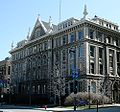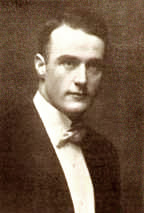 At last fall’s annual conference, the National Sports Law Institute presented its “Master of the Game Award” to the Tierney Family of Milwaukee. At the ceremony Dean Kearney spoke eloquently regarding the Tierney family’s four generations of service to the Wisconsin legal community, to Marquette, and, more recently, to the National Sports Law Institute.
At last fall’s annual conference, the National Sports Law Institute presented its “Master of the Game Award” to the Tierney Family of Milwaukee. At the ceremony Dean Kearney spoke eloquently regarding the Tierney family’s four generations of service to the Wisconsin legal community, to Marquette, and, more recently, to the National Sports Law Institute.
Four generations of Joseph Tierneys have practiced law in Milwaukee. The first, Joseph Tierney I (1886-1945), was a member of the Marquette College of Law’s original day division class that began the study of law in the fall of 1908. Unlike most of his original classmates, he also completed the course three years later and received his degree at the 1911 Marquette Commencement.
Tierney was born in Menominee, Michigan, on May 5, 1886, the son of William and Bridget (Welsh) Tierney, both of whom were natives of Ireland who had emigrated to the United States in the 1870’s.
The family had initially settled in Marquette, Michigan, where William Tierney engaged in the lumber business and in mining. Unfortunately, both of Joseph Tierney’s parents died while he was a teenager, leaving him orphaned at age 16. He attended public schools in Michigan, and in 1906, he moved to Milwaukee to attend Marquette Academy. After a year in the academy, he enrolled as a student in Marquette College.
Near the end of Tierney’s first year in the college, Marquette, now Marquette University, acquired the independent Milwaukee Law School and the recently created Milwaukee University School of Law, and combined the two institutions into the Marquette University College of Law. Both schools had offered instruction only in the evening, but the new parent institution planned to operate both a part-time evening and a full-time day law program. When the day law program was announced, Joseph Tierney transferred from the college to the law school. (At this point, one could enter the day law program if one was a high school graduate or able to pass an equivalency examination.)
In September 1908, 24 students enrolled as first year students in the new day program. (An additional 53 students enrolled as first year students in the evening programs.) Tierney and his classmates paid the princely sum of $100 for the full-year’s instruction. The dean of the law school was recently retired United States Circuit Court Judge James G. Jenkins.
According to the following year’s law school bulletin, Tierney’s first semester of law school included courses in Agency, Contracts, Domestic Relations, and Partnership that met for two hours each week, and courses in Common Law Pleading, Real Property, and Criminal Law and Procedure that met for a single hour, for a total of eleven hours of classroom instruction per week.
The fall semester began in September and ran through the first week of February. Classes were held in Johnston Hall (pictured above), and all day classes met between 8:30 a.m. and noon. As there were no full-time law school faculty members in 1908, all of the classes were taught by part-time instructors who were also either practicing lawyers or judges. Several of his classes were taught by the former faculty members of the Milwaukee Law School and the Milwaukee University Law School, all four of whom continued to teach at Marquette after the take-over.
During the spring semester, which began on February 4 and ended on June 24, Agency and Domestic Relations were replaced by two-hour courses on Partnership and Bailments and Carriers. In addition, Contracts now met three rather than two hours per week. All the other classes continued in the same format for a total of twelve hours of instruction.
Only seventeen of the twenty-four original day students enrolled for the second year of law school in the fall of 1909. The returning students took six two-hour courses in the fall — Real Property (essentially a continuation of the first-year Real Property course), Code Pleading and Practice, Personal Property and Sales, Negotiable Paper, Private Corporations, and Equity Jurisprudence, for a total of twelve hours of instruction. In the spring, Personal Property and Negotiable Paper were replaced by Evidence and Municipal Corporations. Code Pleading was reduced from two hours to one, and a one-hour course on Courts and Jurisdiction was added to the schedule.
At the beginning of Tierney’s third year of law school, the school moved to its own building, the former Mackie Mansion at the corner of Grand (later Wisconsin) Avenue and Eleventh Street. There were no elective courses at Marquette during the early years of the law school, so all third year courses were required as well. In the fall, Tierney and his classmates (now reduced in number to twelve) took their fifth consecutive semester of Real Property (a two-hour course), along with two-hour courses in Equity Jurisprudence and Trusts, Wills, Evidence, and Municipal Corporations and Public Utilities as well as one-hour courses in Constitutional Law, Insurance, and Surety and Guaranty. Altogether, the fall third-year classes totaled 13 hours of class time.
In the spring, the Real Property sequence came to an end, and students instead took a two-hour course in Federal Courts, which included Admiralty, Bankruptcy, Patents, and Trademarks. Equity Jurisprudence and Constitutional Law continued in the fall format. Wills was replaced by Probate Practice, and Evidence by Equity Pleading. Municipal Corporations gave way to a one-hour class in Extraordinary Legal Remedies. Instead of Insurance and Surety and Guaranty, students took one-hour courses in Damages and Taxation and Public Revenues, for a total of twelve hours.
Altogether, the three-year course consisted of seventy-two hours of “weekly” instruction. While this may seem low by modern standards, the actual amount of classroom instruction each semester was close to today’s total. Early twentieth-century “hours” contained sixty minutes (unlike today’s law-school hour, which typically amounts to only fifty or fifty-five minutes), and the semester ran for approximately twenty weeks compared to today’s fourteen to fifteen weeks.
In addition to their regular classes, Tierney and his fellow students attended “special lectures” offered by special visiting lecturers who spoke on topics not otherwise covered by the regular courses. Among the lectures during Tierney’s time at the Law School were Dean Jenkins, who lectured on federal jurisdiction and intellectual property; Dr. William Cronyn of the Marquette Medical College, an expert in forensic medicine; and Chicago-based United States District Court Judge Kenesaw Mountain Landis, the future commissioner of baseball. Landis spoke on public attitudes toward the judiciary.
At the June 21, 1911, Marquette University Commencement (held at the Pabst Theatre) Tierney was one of nine recipients of the bachelor of laws degree. Although he probably didn’t do this, Dean Jenkins actually could have addressed the incoming day class back in September of 1908 with the admonition, “Look to your left, then look to your right. Only one of the three of you will still be here by the time of graduation.” Even with their diminished numbers, the law class accounted for almost fifty percent of the degrees awarded at the Marquette University Commencement in 1911. Only nine students earned bachelor’s degrees from the college, and a single student received the degree of Master of Arts. (There were also ten honorary degrees awarded.) The medical school and its affiliates held their own separate commencements in the early twentieth century.
Tierney took and passed the Wisconsin bar examination shortly after his graduation and was admitted to the Wisconsin bar in July 1911. He began practice in Milwaukee and West Allis, where he was to remain for the rest of his life.
Until recently, a graduation photograph of the members of the Law School’s class of 1911, including Joseph Tierney, hung in the student lounge in the basement of Sensenbrenner Hall. The composite photograph will no doubt surface before too long in Eckstein Hall.
 The students who enter Marquette University Law School this year will take a first-year course load consisting of one-semester courses in Torts, Contracts, Civil Procedure, Property, Criminal Law, and Constitutional Law, and a year-long course in Legal Research and Writing. After the first year, the curriculum is largely elective, although the diploma privilege makes Evidence, Professional Responsibility, and Trusts and Estates upper-level required courses.
The students who enter Marquette University Law School this year will take a first-year course load consisting of one-semester courses in Torts, Contracts, Civil Procedure, Property, Criminal Law, and Constitutional Law, and a year-long course in Legal Research and Writing. After the first year, the curriculum is largely elective, although the diploma privilege makes Evidence, Professional Responsibility, and Trusts and Estates upper-level required courses.
